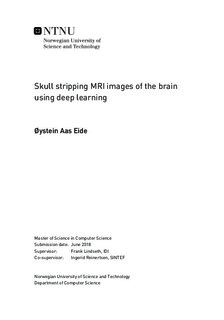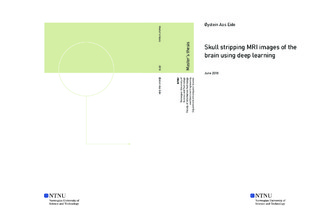| dc.description.abstract | Skull stripping is the task of finding pixels or voxels that establishes where the brain is in amedical image. It is an important step for many medical applications that analysis the brain.Today manual skull stripping is still the best way to get good and accurate results. Manual skullstripping is a laborious process since it can take between 6 and 8 hours (Eskildsen et al., 2012).There exist many tools for performing skull stripping automatically. Some of these tools arevery good, but they can struggle on Magnetic Resonance Imaging (MRI) scans with differentmodalities (Kleesiek et al., 2016). In this decade deep learning has become very popular invarious fields including medical image analysis, which includes tasks such as medical imagesegmentation. According to Litjens et al. (2017) the amount of published papers on this subjecthave gone from close to 0 in 2012 to over 200 papers published in 2017. In this thesis threedifferent deep learning architectures will be used to do skull stripping. Also, an experiment onliver segmentation will be done to see if the methods will work on other medical imaging tasks.The deep learning architectures will be tested on three different data sets containing MRI scansof the brain. One of these data sets contains only patients with tumors. The architectures weretrained on different data sets to test how well they will perform when they are faced with MRIscans from different sources. Various experiments will be done to see how training and testingon different compositions of these data sets will make the architectures perform.Deep learning methods take a long time to train. In this thesis, the deep learning architectureswill be tested on different hardware configurations to see how long they take to train on thedifferent set ups. In total four different configurations will be tested with different CentralProcessing Units (CPUs) and different Graphics Processing Units (GPUs). | |

